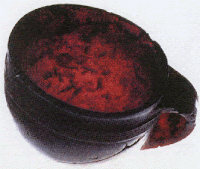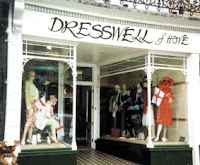 Yesterday was the first Sunday of the month, and naturally that could mean only one thing: 'Landscape by Lamplight II: Hove, Actually'. It might sound like a Merchant Ivory sequel by Richard Curtis (perish the thought), but this was in fact the follow up to last month's moonlit jaunt around the seedier side of Brighton's past. And unlike a Merchant Ivory film, I actually wanted to go to this.
Yesterday was the first Sunday of the month, and naturally that could mean only one thing: 'Landscape by Lamplight II: Hove, Actually'. It might sound like a Merchant Ivory sequel by Richard Curtis (perish the thought), but this was in fact the follow up to last month's moonlit jaunt around the seedier side of Brighton's past. And unlike a Merchant Ivory film, I actually wanted to go to this.Like February's guided walk, this hobble around Hove was led by local historian Geoffrey Mead, who turned up dressed in a black hat and coat looking like a cross between Johnny Cash and a rabbi, and describing the weather as 'balmy'. Though I'm not sure how he's spelling that. The official meeting point for the event was the floral clock in Palmeira Square, but having turned up five minutes early, Lisa and I (oh yes, I persuaded her to come) soon discovered that the actual meeting point was a bus shelter across the road. Geoff may be enthusiastic about his work, but even he won't stand about in the rain.
A bit of laughing and pointing at the man's hat and we were off, with Brighton's answer to Simon Schama leading us straight across the road, over a chained barrier, past the 'Keep Off the Grass' signs, and onto a prime patch of turf at the bottom of Palmeira Avenue. This, he told us, was the location of an exceptional archeological find, when an amber cup was discovered during excavations in 1852. Despite looking like half an Easter egg with a handle, this cup is important enough to have its own Wikipedia page, and is, according to Geoffrey, "magnificent". I'm not saying he's wrong, but the picture's above - you be the judge.
Interestingly enough, the site of the floral clock was once home to an ambitious iron and glass dome, designed by architect Amon Henry Wilds in 1832. Unfortunately he lost patience with his clients when they repeatedly altered his plans during construction and told him his central supporting column was an unnecessary expense. As a result he pulled out of the project, they removed the column, and the building promptly collapsed. Apparently Amon was so traumatised by the event that he went blind. Which is a shame, because if he'd gone on to design houses, he could have called himself Amon Homes.
Anyhoo, as it happens the glass dome wasn't the only thing which came tumbling down in Palmeira Square: the rain was pretty torrential by this point too. So having climbed back over the barrier designed to keep the likes of us out, Geoffrey led us south towards the seafront... and straight into a force nine gale. I'd like to pass on some fascinating facts about regency architecture, but unfortunately I was distracted by my umbrella turning inside out, then breaking, then my realisation that Adelaide Crescent was essentially one big lake and I was standing in it up to my ankles. So it's all a bit of a blur. But I do remember thinking that somewhere called Adelaide really ought to be warmer in March.
 Fortunately we made it around the corner and into First Avenue, where we stopped at number 12 to look at the blue plaque on the right and admire the childhood home of Patrick Hamilton, writer of 'Gas Light', 'Rope' and (according to Graham Greene) "the best book written about Brighton", 'The West Pier'. Sadly the man was also an alcoholic, and by the 60s he'd had enough of 'Rope' to hang himself, resulting in his death from liver failure in 1962. The blue plaque was paid for by Penguin Books, who I'm sure did it as a mark of respect, and not in an attempt to shift a few copies of his last paperback.
Fortunately we made it around the corner and into First Avenue, where we stopped at number 12 to look at the blue plaque on the right and admire the childhood home of Patrick Hamilton, writer of 'Gas Light', 'Rope' and (according to Graham Greene) "the best book written about Brighton", 'The West Pier'. Sadly the man was also an alcoholic, and by the 60s he'd had enough of 'Rope' to hang himself, resulting in his death from liver failure in 1962. The blue plaque was paid for by Penguin Books, who I'm sure did it as a mark of respect, and not in an attempt to shift a few copies of his last paperback.From there we made our way north by northwest (which is one Hitchcock film Hamilton didn't write) into Grand Avenue, past the war memorial, and down to the southern end where Geoff informed us that the homes used to feature baths with three taps: one for hot, one for cold, and one for seawater, which was pumped in from giant tanks beneath the road. These tanks were sealed up some years ago. Possibly around the time they invented Radox.
Nearby is the Queen Victoria Memorial, created by sculptor to the stars, Sir Thomas Brock, more than a hundred years ago. Apparently it was due to be unveiled on the 25th of January, 1901. Which is a bit of a shame as Victoria died on the 22nd. Timing never was her strong point.
By now we'd absorbed quite a lot of history, and it was clearly having an effect on Lisa. As we made our way along the seafront, fully immersing ourselves in the rich atmosphere of Hove's glorious past, Lisa turned to me with a look of quiet contemplation in her eyes and said...
"Can we go to McDonalds after this?"
Naturally I said yes. It's not wise to argue with a woman who looks like the Grim Reaper. (That was her own fault for wearing a hood). (Although the scythe didn't help).
Turning inland again, we headed up through Osborne Villas which, according to the woman walking in front of me (who was not so much a guide as a gossip), featured the former home of Jordan's Mum. Strangely, that one didn't have a blue plaque.
 From there it was back into Church Road, past the traditional ladies clothes shop 'Dresswell of Hove', followed a few doors down by the traditional men's toupé shop 'Rug World' (or possibly they just sell carpets).
From there it was back into Church Road, past the traditional ladies clothes shop 'Dresswell of Hove', followed a few doors down by the traditional men's toupé shop 'Rug World' (or possibly they just sell carpets).Heading across Wilbury Road, where Freemasons go to die (apparently), we soon arrived back in Palmeira Square. Geoffrey ended by telling us that Brighton has more restaurants per head of population than anywhere outside of London and Edinburgh. I thought for a moment it was his way of inviting us all out to dinner, but sadly he just passed the hat around (literally) for a donation to 'The Friends of Hove Museum'. I thanked him and handed over a pound. I don't make friends easily.












0 comments:
Post a Comment